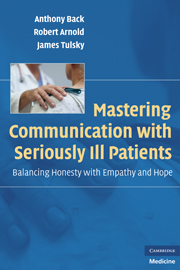Book contents
- Frontmatter
- Contents
- PREFACE
- 1 TAKING YOUR SKILLS TO THE NEXT LEVEL
- 2 GETTING A GOOD START
- 3 TALKING ABOUT SERIOUS NEWS
- 4 DISCUSSING EVIDENCE FOR MAKING TREATMENT DECISIONS
- 5 DISCUSSING PROGNOSIS
- 6 BETWEEN THE BIG EVENTS
- 7 CONDUCTING A FAMILY CONFERENCE
- 8 DEALING WITH CONFLICTS
- 9 TRANSITIONS TO END-OF-LIFE CARE
- 10 TALKING ABOUT DYING
- 11 CULTIVATING YOUR SKILLS
- APPENDIX A THE ROADMAPS IN OUTLINE FORM
- APPENDIX B ACKNOWLEDGMENTS
- INDEX
APPENDIX A - THE ROADMAPS IN OUTLINE FORM
(so you don't have to search through the book)
Published online by Cambridge University Press: 23 November 2009
- Frontmatter
- Contents
- PREFACE
- 1 TAKING YOUR SKILLS TO THE NEXT LEVEL
- 2 GETTING A GOOD START
- 3 TALKING ABOUT SERIOUS NEWS
- 4 DISCUSSING EVIDENCE FOR MAKING TREATMENT DECISIONS
- 5 DISCUSSING PROGNOSIS
- 6 BETWEEN THE BIG EVENTS
- 7 CONDUCTING A FAMILY CONFERENCE
- 8 DEALING WITH CONFLICTS
- 9 TRANSITIONS TO END-OF-LIFE CARE
- 10 TALKING ABOUT DYING
- 11 CULTIVATING YOUR SKILLS
- APPENDIX A THE ROADMAPS IN OUTLINE FORM
- APPENDIX B ACKNOWLEDGMENTS
- INDEX
Summary
CHAPTER 1: TAKING YOUR SKILLS TO THE NEXT LEVEL (OUR BASIC PRINCIPLES)
Start with the patient's agenda.
Track both the emotion and the cognitive data you get from the patient.
Stay with the patient and move the conversation forward one step at a time.
Articulate empathy explicitly.
Talk about what you can do before you talk about what you can't do.
Start with big-picture goals before talking about specific medical interventions.
Spend at least a moment giving the patient your complete, undivided attention on your computer and show him you are listening.
CHAPTER 2: GETTING A GOOD START
Make a welcoming statement.
Ask about the patient's main concerns for the visit.
Explain your agenda for the visit.
If the patient has more concerns than you think you can address in the amount of time you have, ask the patient to prioritize them.
Propose an agenda for the visit.
Ask the patient for feedback about the agenda.
- Type
- Chapter
- Information
- Mastering Communication with Seriously Ill PatientsBalancing Honesty with Empathy and Hope, pp. 145 - 150Publisher: Cambridge University PressPrint publication year: 2009



